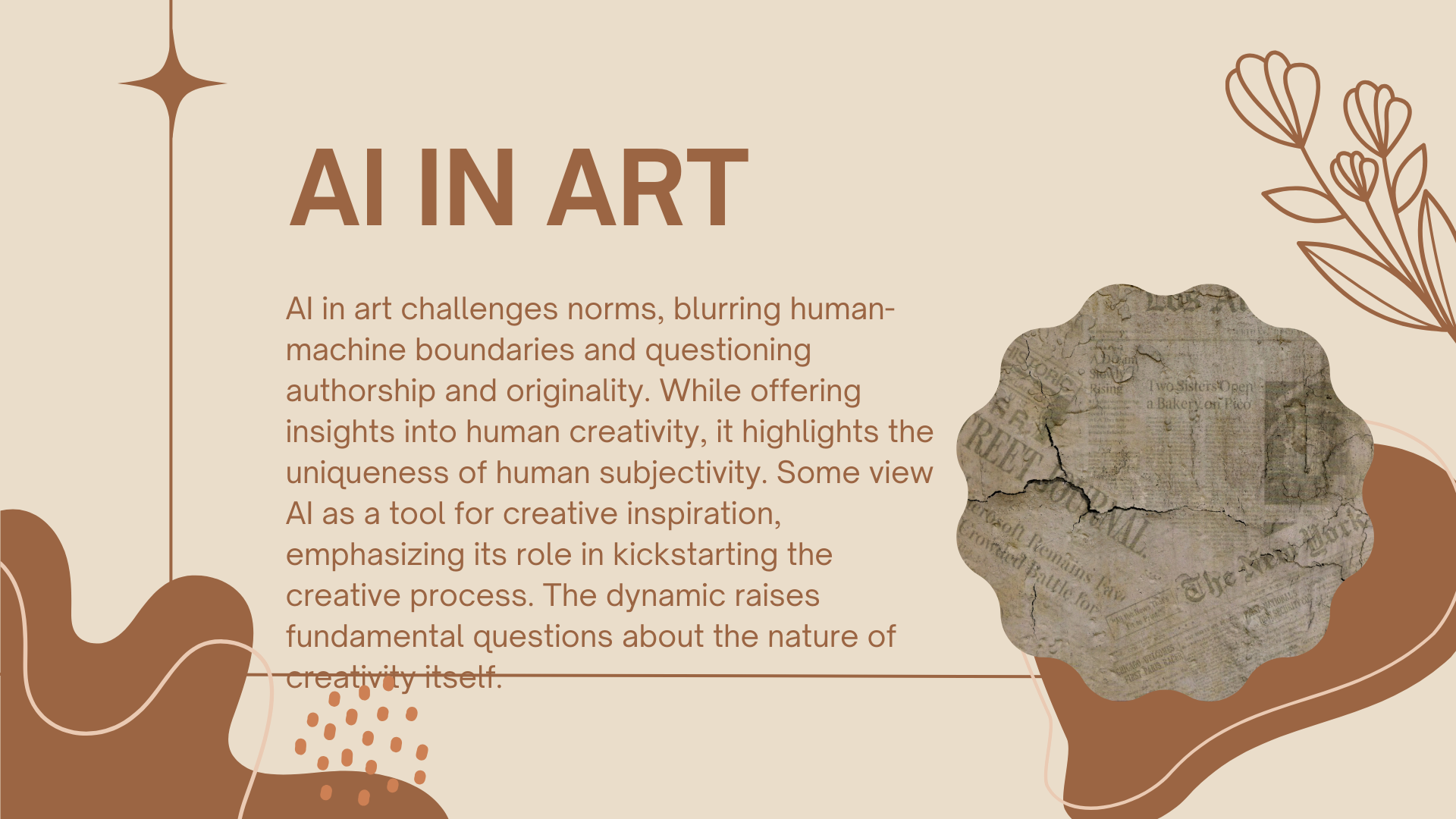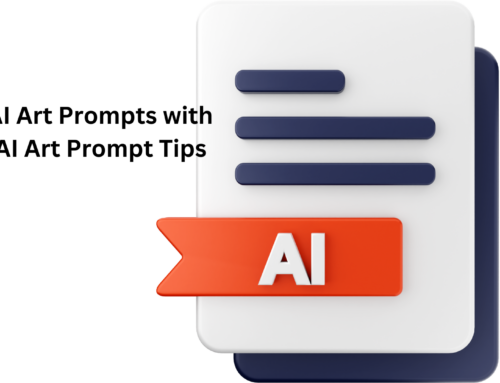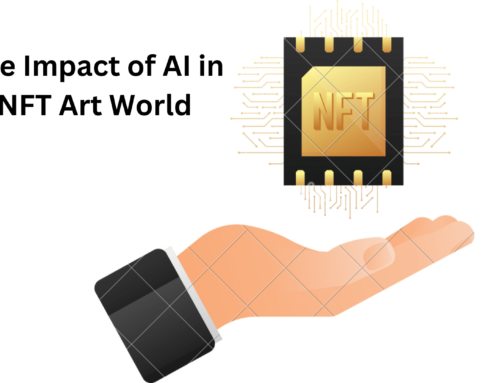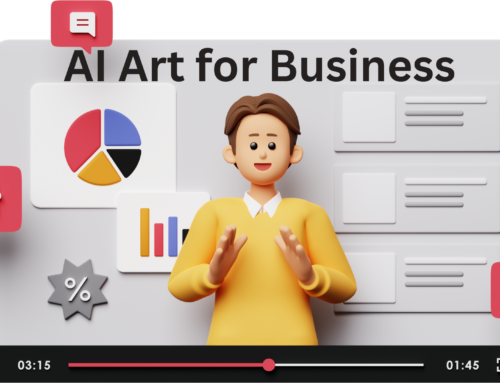Ever wondered what happens when super-smart computers team up with the colorful world of paintings and sculptures? It’s a bit like having a robot Picasso in the studio! Let’s dive into the cool mix of AI and the philosophy of AI art.
So, what’s the buzz about the philosophy of art? Well, imagine computers learning to create art by studying tons of paintings, patterns, and feelings. Sounds wild, right? But here’s the real deal, can a machine truly get what makes art so special to us humans?

Human vs. Machine and the Philosophy of AI Art
Art has always been something humans do, like doodling in notebooks or making beautiful paintings. Now, AI is trying to join the art party. But, hang on, can a computer really understand the deep emotions behind a painting? Is it just about pretty pictures, or is there something more profound?
Amy Hsu, the Marketing Director of YGM Reflective, says, “Yes, AI-generated art challenges established definitions of art and creativity by blurring the boundaries between human and machine-generated creations, raising questions about authorship, originality, and the role of intentionality in artistic expression.
The philosophical implications of machines producing art that evokes emotions and resonates with human audiences raise questions about the nature of creativity, the uniqueness of human experience, and the potential for AI to contribute to cultural production and aesthetic appreciation in unprecedented ways.
AI art offers insights into the nature of human consciousness and artistic expression by revealing patterns in human-created art and facilitating exploration of creativity through computational processes. However, it also underscores the distinctiveness of human subjectivity and the complexities of artistic interpretation and meaning-making.”
With AI making art that looks pretty human, we’re left wondering, does it mess with our idea of what art and creativity really are? We’ve always thought creativity is something only us humans can claim, right? But now, with machines jumping into the artistic scene, it’s like, Can machines really be creative like us? It’s like redefining the rules of the creative game.
Stephen Conley, The Founder & Creative Director of Gisteo, says, “I see AI as a powerful tool to generate creative imagery. At Gisteo, I find it especially helpful to create conceptual images for our storyboard productions. Like any tool, I think we need to apply a filter and separate how we use these images for inspiration vs. simply copying and pasting them. For inspiration, AI is a true game-changer in my industry and it truly helps to kickstart the creative process.”
Is Generative AI in Art a Friendly Competition or a Collaboration Between Humans and Machines?
Let’s step into the exciting world of AI art, where artificial intelligence (AI) becomes friends with human artists. Imagine a human artist and AI teaming up to create mind-blowing ai-generated art. Now, let’s chat about the deep stuff with the thinkers, the philosophers. They’re pondering aesthetics and the exact definition of art in this new twist. They’re wondering if algorithms, neural networks, and generative AI can really create art that matches the beauty and emotion of traditional pieces. It’s like a philosophical journey, exploring not just the history of art but also thinking about the role AI plays in defining the philosophy of AI art.
As we dig deeper into the philosophy of AI art, let’s talk about human creativity. Using AI tools to make artwork brings up cool questions about the definition of art. Can AI replace human artists, or is it more like a helper in the creative process? This mix of human smarts and generative AI shakes things up, redefining what it means to make art. It’s like blending the old-school art vibes with the possibilities of the future.
In the big picture of art, the philosophy of AI takes the spotlight, weaving together traditional art and fancy technology. The neural networks and algorithms used to generate art mess with what we thought we knew about creativity. They make us rethink how artists, both human and AI, create a piece of art. So, this partnership isn’t just making art but also creating deep questions that philosophers love exploring in the world of the philosophy of AI art.
A Philosophical Exploration of AI Art in Creativity
Now, let’s talk about the fascinating mix of art and AI, it’s like getting the cool tech stuff into the art world. The question buzzing around is whether AI can really shake up how we see and make art. In this age of AI, where fancy technology meets artistic vibes, we’re not just talking about art with humans but also art with AI. It’s like a dance between traditional art forms and the magic of AI-generated art, pushing the boundaries of what we thought art could be.
In the contemporary art scene, artists are using AI in art creation, and it’s turning into a bit of a competition, like a friendly match between humans and machines. The emergence of AI artists and the integration of AI in art bring fresh perspectives. Now, think about art without the traditional rules, it’s art that flies with the aesthetics for birds, a kind of art that breaks free from the usual understanding of art. So, as we explore this new world of art in the age of AI, it’s not just about what art would look like; it’s about redefining how we imagine and create art with the helping hand of technology.
AI’s Implications and Possibilities in the Art World
Now, let’s talk about the world of AI in art, sparking thoughts about the philosophy of AI art. Some folks worry that AI might disrupt traditional art forms, but it’s essential to consider the fresh view it brings to the art table. Here are a couple of points to ponder:
- AI Algorithms Taking the Stage: With AI algorithms stepping into the art scene, it’s like they’re putting on their own show, challenging the way we usually make art.
- Generative Art Changing the Game: The rise of generative art, powered by AI, is like a game-changer. It’s not just about creating; it’s about art that creates itself, breaking away from the usual artist-driven path.
- Implications of AI in the Future: Considering art in the future, AI brings a whole new set of possibilities. It’s not just about creating beautiful pieces; it’s about redefining the very essence of what we call art.
- Questions Around AI Regulation: As AI becomes a big player in the art game, questions about how to regulate its role pop up. It’s like figuring out the rules for this new player on the creative field.
- Philosophy at the University Weighing In: The folks studying philosophy at the university are deep into these conversations. They’re not just thinking about art created by humans but also art generated by AI, pondering the implications and possibilities.
So, when we think about AI in art, it’s not just about worrying if it’ll change things but also about welcoming the exciting new perspectives it brings to the canvas.
Art’s End or Renaissance?
Let’s dive a bit deeper into the philosophy of AI art. Some people argue that AI might bring an end to art as we know it. They worry that the essence of art, that unique human touch, could vanish if everything is produced by AI. But here’s a twist – others believe that AI art might actually add a fresh flavor to the world of art. It’s like a new era of creativity, where AI-generated images blend with the traditional forms of art, creating a unique fusion. Now, think about the brains behind AI-generated art; it’s not just about the computer algorithms, but it’s also about the humans doing the AI research. The interplay between technology and the philosophy of mind adds a layer of complexity to this artistic journey. As we step into this era of AI, the discussion around whether AI would destroy art or enhance it becomes a fascinating part of the evolving world of art.

Airbrush AI and the Evolution of AI-generated Art
Let’s talk about this cool tool called Airbrush AI. It’s like magic for creating pictures from text. You tell it what you want, and poof! It turns your words into beautiful images. Now, in the grand picture of the philosophy of AI art, tools like Airbrush AI play a special role. They step into the shoes of artists, helping define art in a whole new way. It’s like a friendly assistant in the art world, showing us how the role of AI is evolving and shaking hands with art history. So, as we explore the philosophy of AI art, tools like Airbrush AI become our art buddies, adding a unique stroke to the canvas of creativity.
Here’s a glimpse of its features and benefits:
- Text to Image Magic: Airbrush AI works like a charm, turning your written ideas into vibrant images effortlessly.
- Artistic Assistance: It’s not just a tool; it’s your friendly art assistant, helping you bring your creative vision to life.
- Effortless Creativity: No need to be a tech whiz or an art expert. With Airbrush AI, creativity flows seamlessly from your words.
- Redefined Role of AI: In the philosophy of AI art, Airbrush AI showcases how technology steps into the shoes of artists, redefining the traditional role of AI in the creative process.
- Art History Integration: As we define art in new ways, tools like Airbrush AI become companions in the journey, bridging the past and the future of artistic expression.
Concluding the Journey of Human-AI Creative Fusion
In the big picture of AI art, it’s like we’re exploring a whole new way of creating where humans and machines team up. The use of artificial intelligence isn’t just about making art pieces; it’s part of a bigger art movement. Now, what makes art often gets people talking. Can independent AI be thought of as an artist? The line between human and machine creativity blurs as AI artworks make their mark. It’s like the artist must now share the stage with the algorithms. In this changing world, the phrase “the artist” takes on a new twist, including both human and machine contributions. So, as we wrap up our artistic adventure, it’s clear – art also changes, embracing the unique mix of human and AI creativity, painting a future where both play important roles in shaping the ever-expanding world of art.








Leave A Comment